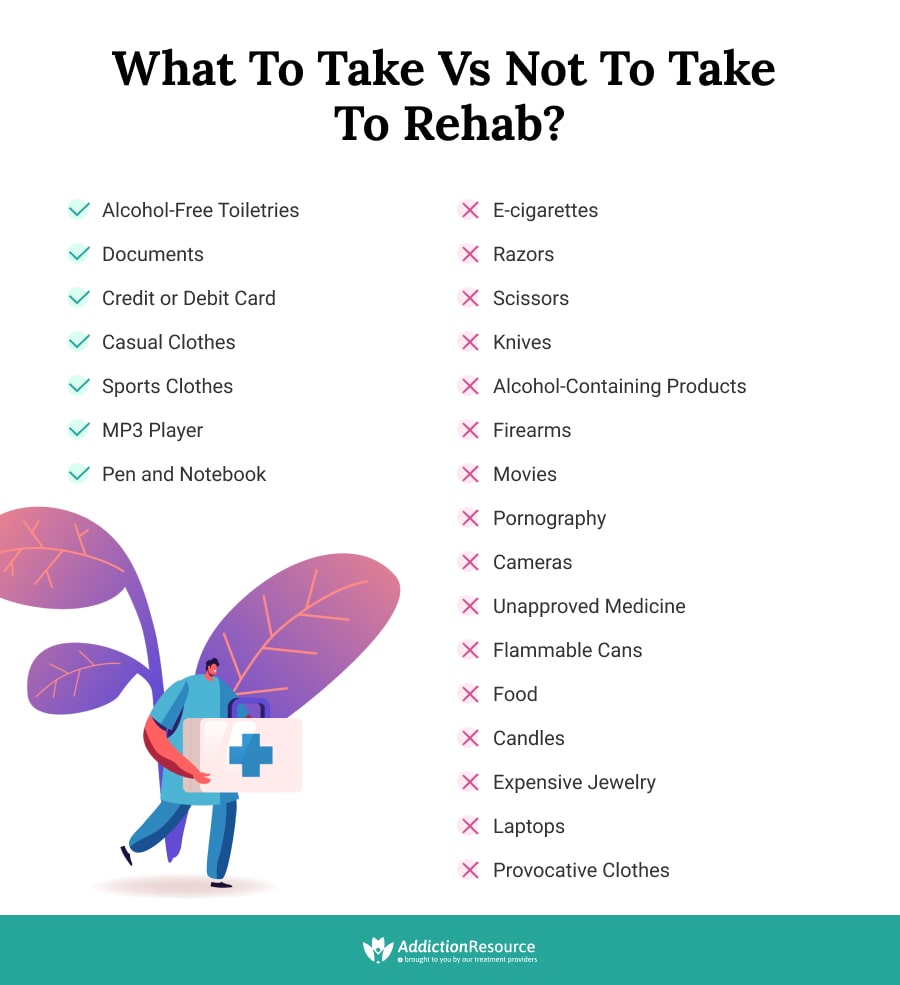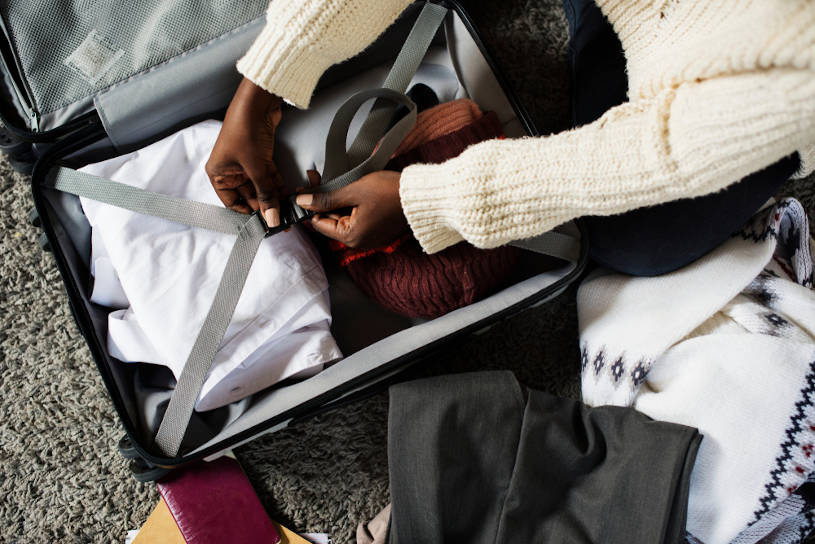
Once a person has decided to start rehab for addiction treatment, they may wonder what rehabilitation would be like. Many people enter rehab for the first time and are unaware of what to expect, what things to bring to rehab, and what needs to be done to prepare them and their families for going to rehab. Before going into a treatment center, the person needs to take care of his family, commitments, finances, and many other aspects. There are many dimensions of preparing for rehab, which includes physical as well as emotional challenges.
Table Of Contents:
- How To Tie The Loose Ends Before Treatment?
- Why Is It Necessary To Avoid The Last Binge?
- How To Prepare Oneself Emotionally For Rehab?
- What Items Can One Bring To Rehab?
- What Items Are Prohibited To Bring?
- How To Make Treatment At The Rehab Comfortable?
- How to Gain Motivation During Treatment?
- Why Do People Fail Drug Rehab Courses?
- Is There An Easy Way To Recovery?

Read along further to learn how one can be prepared for rehabilitation, the packing list for inpatient rehab, what not to bring to rehab, and how to make treatment as comfortable as possible.
Tie up Loose Ends Before Going To Rehab: Financial, Work, and Family Obligations
All financial, work- and family-related obligations need to be taken care of before one can start rehab. Unfulfilled obligations are a distraction when undergoing treatment. What is more, returning to a chaotic situation after rehab is stressful and can make one more prone to relapse.
- Be sure to spend time with close relatives and friends before leaving, especially if the center is far from home – this could help reduce fear and anxiety. According to SAMHSA, family members often have a bigger desire to achieve a better-functioning family system, thus helping the patient remain in treatment through periods of doubt and ambivalence about recovery.
- Check with the employer about work and job status while taking this leave of absence. According to the Family and Medical Leave Act (FMLA), most employers provide job security and unpaid leave up to 12 week.
- One should also check with their insurance provider about what kind of treatment and service they cover. Some insurances cover the cost of treatment but do not cover the logistics and travel expenses. Similarly, some insurance providers might cover the medicines, but the client is responsible for their co-pays. So having an idea about all the financial aspects can help one plan accordingly.
- Parents going to rehab have several childcare options available. The best choice would be someone the child or children already know and feel safe with, like a significant other or grandparent, another older relative, or a close friend. Some treatment facilities provide childcare services to their clients or allow them to stay with their parents there.
- Take care of things at one’s home, like who will pay the bills and collect the post in the absence of the patient. To save money, one can suspend their phone call services and set up an outgoing message for voicemail and email. If one has pets, adequate arrangements have to be made for them, so that the patient can start rehab without any distractions or worries back home.
All the aspects mentioned above need to be taken care of before one moves on to the next step of thinking and preparing essentials you can bring to rehab. A care package for someone in a treatment center includes several essentials, whereas certain things are prohibited.

Avoiding That Last Binge: Physical Aspects
One must try to stay sober before entering rehab. This can be a difficult task for the patients since they think they will start rehab anyway, so why not indulge in that last binge. But maintaining abstinence can help the patient when they start rehab therapies. At the start of rehab, patients go through the process of detox. If one is under the influence of a final binge, it will lengthen the detox process and can create additional problems during the rehabilitation process. A final binge also carries the risk of overdose, which can prove disastrous for the patient.
Rehab-Ready Mindset: Emotional Aspects
When a person is about to start rehab, it means having to make changes not only physically but also emotionally. Only with a positive mindset can one be able to go through rehab smoothly and effectively.
Here Are a Few Tips on How One Can Prepare Emotionally for Going to Rehab:
Prepare One’s Mind
One of the first steps is to prepare oneself and approach treatment with an open mind. Having a firm belief that one will come out of the rehabilitation process successfully and sober can help prepare a positive mind before going to rehab.
Practice Stress-Relief And Relaxation Techniques
To prepare themselves for addiction treatment emotionally and mentally, many people have found going for walks, taking deep breaths, and spending time doing crafts or DIY very helpful. Engaging oneself in hobbies and other forms of healthy entertainment are also helpful.
Gather Information About Rehab
Going to rehab is a great way to learn more about addiction and recovery. This includes reading specialized literature and resources about addiction, what the treatment involves, and the statistics and science behind it. In addition, there are many first-hand accounts from recovering addicts online. These resources can be very interesting and informative and help one prepare for going to a treatment center.
Spend Time With Friends And Family
Spending time with friends, family, and loved ones before rehab can help the client remain motivated and stress-free. They can help to focus the client and make him positive about the future.
Work On Creating A Routine And Good Sleep Habits
Having adequate rest and sleep allows our mind and body to be at ease and promotes overall health and wellness. In addition, creating a regular routine and having adequate rest allows one physically and emotionally to get prepared for rehab.

What To Take To Rehab? Items to Bring
A prospective patient of a rehabilitation center may think about what can you bring to rehab? There are certain essential things that one can bring with them while going to a rehabilitation center which can give the person an idea of what to pack for rehab.
The Packing List for Inpatient Rehab Can Include the Following:
Alcohol-Free Toiletries
Alcohol-free toiletries are part of the things to bring to rehab. Patients are advised to bring toiletries to avoid additional expenses in rehab. Understandably, none of these should be alcohol-based. In cases of alcohol detox, strong cravings have compelled people to drink spray gel or perfume.
Things to Take Are:
- Toothbrush and toothpaste
- Soap or body wash
- Shampoos and conditioners
- Alcohol-free mouthwash
- Deodorant
- Hairbrush or comb
Documents and Contact Info
Having a list of important phone numbers is recommended for obvious reasons. As mentioned, most centers don’t allow their patients to use their cell phones, so they can’t get any numbers out of them that they may need. Before checking in, one should write down a few important numbers, like close friends and family members, an attorney, or a physician. Stamps to mail letters and postcards are a good idea, as this is basically the only way to stay in touch with loved ones during rehab. Finally, one needs to take care of eyewear, where relevant – eyeglasses, contact lenses, lens solution, and other accessories as needed. They can also be included in what to take to rehab.
Recommended Items Are:
- Currently prescribed medications, prescription, and insurance cards
- Government ID (driver’s license or passport)
- Important contact information for the primary care physician
Money
- Some rehabs allow the patient to bring some money which is deposited in his name and distributed as needed.
- A credit or reloadable debit card
Clothing
Patients are discouraged from bringing provocative clothes to treatment facilities as these can distract them and those around them from moving forward in therapy. A lot of facilities organize sports activities, including hiking trips and swimming. Revealing bikinis are not allowed, and people who haven’t brought any alternatives will be left out of trips to the beach or waterpark, and that can be a downer. Hiking shoes, a beach towel, and sunscreen are some of the things to bring to rehab. People find they need comfortable clothes once they get settled in, like sweatpants and slippers. High heels are seen as inappropriate and are also usually not allowed.
A Suitable Clothing List Should Be Like:
- Casual clothes for daily use that cannot be vulgar or sultry
- At least a week of casual clothing suitable for local daytime and evening temperatures
- Laundry detergent
- Undergarments and socks
- Sports clothes and modest swimming costumes
Electronics
Of course, a person needs more than the bare essentials in rehab, especially if they plan on spending more than a month there. It’s a good idea to find an old MP3 player or iPod (with a charger) – people beat the boredom or bouts of depression that can go with rehab by listening to their favorite music. Old iPods and MP3 players may not be very easy to find today, but there could be one laying around a friend’s house somewhere.
Most treatment facilities don’t let patients bring a cell phone or any other device with an Internet connection because these devices can be used to take photos that violate other patients’ privacy, leave against medical advice, or get prohibited substances into the drug rehab center.
Example of Allowed Items is Provided Below:
- Portable music devices like an MP3 player or an iPod
- Some rehabs allow the use of mobiles and laptops under their supervision to be included in what to take to rehab.
Cigarettes
Patients who smoke find their nicotine intake skyrockets in rehab. If a person usually smokes ten cigarettes a day or fewer, they may need up to one pack per day. A large part of the day will be taken up by individual and group therapy, recreational activities, and meetings, but there is still a lot of free time. Patients are often outside chain-smoking and socializing when there isn’t a lot going on at the addiction center. Slippers are very convenient because one doesn’t feel like tying their shoes every time they go outside for a smoke or to chat.
Verify the Rehab’s List of Permitted and Prohibited Items
It is always a good idea to verify from one’s treatment center about the things to bring to rehab and prohibited items since each addiction center has its own rules of permissible or prohibited items.
Always double-check with the concerned rehabilitation center about the things allowed to bring so one can be sure that the care package for someone in rehab is according to the center’s rules and regulations.

What Items Not to Bring to Rehab
Generally speaking, some items may be prohibited to bring in a particular rehab, but always check with the concerned drug rehab center to see which items are prohibited.
Some of the Prohibited Items Include:
- E-cigarettes
- Razors
- Scissors
- Knives
- Any product containing alcohol
- Firearms or ammunition
- Movies
- Pornographic materials
- Cameras
- Unapproved medicines
- Aerosol or flammable cans
A person who has decided to start rehab to get addiction treatment, achieve long-term sobriety and mental health recovery would not think of bringing drugs or alcohol to the facility. Not every patient’s resolve, however, is that strong. Upon intake, each patient’s belongings are searched thoroughly. In light of this, it is pointless to bring alcohol and drugs. Sharp items aren’t allowed, and neither are weapons. One cannot bring knives, guns, scissors, nail files, and tweezers to a treatment center.
In Addition, the Following Items Are Usually Not Allowed in Drug Rehab Facilities:
- Candles and incense
- Foods and beverages
Edible Items
Most addiction treatment centers typically ban outside food and drinks because there is a meal plan to follow, and sugar and caffeine consumption should be limited or completely eliminated.
Most of Rehabs Provide Their patients with:
- nourishing meals
- Snacks
- Alcohol-free beverages
Patients who have special dietary requirements (lactose intolerant, vegetarian, vegan) must inform the drug rehab center in advance.
Products Containing Alcohol
As mentioned above, cosmetic products that contain alcohol are not allowed. These include certain mouthwashes, aerosol deodorants, nail polish remover, and perfume.
Electronics
Clothes referencing alcohol and drug use or profanity are discouraged, as are all types of electronics. This is not only due to the risk of using them to access the Internet, which the staff aren’t willing to take. Gadgets are also seen as a distraction from the matter at hand – learning to live an independent and fulfilling life. Therefore, one should not bring game consoles, tablets, televisions, iPhones, or laptops.
Expensive Items
Large amounts of money and expensive items should not be taken either. Items like expensive jewelry, clothes, and shoes do not belong in rehab or in any facility where one would risk losing them, for that matter.
Unapproved Medication
Patients are not allowed to bring open or unapproved medication. They are required to show a prescription for any medication they do bring. Multi-vitamins and other non-prescription medical products must be reported to the staff in advance. If one is unable to do so, possession of such products must be reported at intake at the latest.
It may be tempting to bring pleasant reminders of home or something else to rehab, but this may hinder recovery. The focus should always be on getting healthy, both emotionally and physically. Reminders may distract from this purpose.

How to Make Treatment Comfortable: The 3 Golden Rules
No one says that drug rehab is like a walk in the park. It is a difficult and challenging time for the patient where they have to learn to let go of the old ways and learn new and positive ways to live a sober, healthy, and productive life. However, there are certain things that a patient can do to make addiction treatment as comfortable as possible.
Be Open-Minded
Rehab patients share many of the same struggles, and often people form life-long friendships or partnerships in treatment facilities. Substance addiction and mental health issues can erode one’s self-esteem, and the notion of making new friends may be unwelcome, especially for those in treatment. It is normal to be afraid of rejection, but it pays off to remember that everybody there is more or less in the same situation. Building relationships in rehab can provide additional support as one embraces sobriety. Being open-minded is key to getting the most out of recovery.
It is difficult to go into addiction treatment without any preconceived notions or expectations, but the more one can embrace the process, the more one will be able to benefit from it.
Speak Up
This point links to the issue of self-esteem. Recovering addicts often struggle with low self-esteem, which can make it hard to speak up in group therapy, which is a major component of the program. By speaking up in group sessions, one makes sure they are getting the most out of them. Time spent discussing issues that are important to an individual in rehab is time well spent.
Patience
Being patient (as both a noun and an adjective) in rehab is challenging but crucial. Of course, it is easier said than done, but if one is able to practice being patient with themselves, other recovering addicts, and the whole process of therapy, they will find there are many short- and long-term benefits to reap. A great way to teach oneself patience is by practicing meditation, which can have a very positive impact on rehabilitation. The key to this is being present and aware of each and every moment. People get impatient when they are not fully present in a situation. Every moment counts – after all, every experience is simply a series of moments.

Gain Motivation By Engaging In Healthy Activities
There are also some other tips that can help a person to make his stay at the rehab as comfortable and productive as possible, e.g., writing a journal or writing a letter to someone in rehab.
Write A Journal
Studies have shown that writing a journal can help greatly during the healing process of recovery in rehab. Through this habit, one is able to pen down all the emotions, what he is feeling, and all his experiences which will help one in understanding and coping with the entire process. This journal can also serve as an excellent reminder of how far one has come in the journey towards recovery. When the person has become sober and has graduated from rehab, he would be able to recollect all his experiences and memories of rehab and be proud of how much they have achieved.
Create A Support System With Peers
When one enters rehab, he leaves all his family and friends behind, which can make him become depressed and lonely. However, one only needs to realize that his peers in the rehab center are also going through the same struggles and problems as himself. They are better able to understand each other and communicate with them. Thus, they will be able to find a support system among their peers, which can even result in lifelong friendships. These friends can help one stay motivated and offer them the support with which they can achieve sobriety and ultimate recovery.
Write Letters
Just like writing a journal, one can write letters to their family, friends, or loved ones. Through writing a letter to someone in rehab, they can express themselves and their emotions in a productive and healthy manner. They would feel that they are being heard, and their connection with their support system is still maintained. All this process of writing a letter to someone in rehab is extremely therapeutic and will result in better outcomes for recovery.
Why do People “Fail” Rehab Programs?
“Failing” a rehab involves terminating participation prematurely, using drugs or alcohol during rehabilitation (and getting caught), or any end result other than the desired one. Some people even go to rehab several times and experience relapse after relapse despite the efforts of therapists and medical staff. There are many reasons why this happens, but certainly, emotional and behavioral responses are often implicated, and these are discouraged in drug rehab.
They include having a negative attitude, whether toward the facility and program or toward life in general, being unwilling to participate in the recovery process, and disregarding the rules of the center.
No Easy Way to Successful Recovery
“There are no secrets to success. It is the result of preparation, hard work, and learning from failure.”Colin Powell, Former Secretary of State
Even those who have made a very firm commitment to get and stay sober long-term can feel deterred by the stress from putting work-related and other engagements on hold. Successful, long-term health recovery takes hard work. It is important to realize that stress and worries can be dealt with by preparing well for addiction treatment.
After all, the most difficult part – deciding to get help – is over. All that is left is taking measures to make it possible to go back to a positive space while going to rehab where the skills learned can be applied.
Hope Without Commitment
Find the best treatment options. Call our free and confidential helpline
Most private insurances accepted
Find Drug Rehabilitation Centers Near You Anywhere In the US
Addiction Resource team has compiled an extensive list of the top drug rehabilitation facilities around the country. Use our locator tool to find the best centers near you.
Page Sources
- Family-Centered Approach. National Center On Substance Abuse And Child Welfare. https://ncsacw.samhsa.gov/topics/family-centered-approach.aspx.
- Family and Medical Leave (FMLA). U.S. DEPARTMENT OF LABOR. https://www.dol.gov/general/topic/benefits-leave/fmla.
- Krzys, T. M. (1995). Journal Writing in Rehabilitation: A Tool to Help Patients and Families Face Challenges and Adapt. Rehabilitation Nursing Journal, 20(4), 226-228. https://pubmed.ncbi.nlm.nih.gov/7617970/
- Priddy, S. E., Howard, M. O., Hanley, A. W., Riquino, M. R., Friberg-Felsted, K., & Garland, E. L. (2018). Mindfulness meditation in the treatment of substance use disorders and preventing future relapse: neurocognitive mechanisms and clinical implications. Substance abuse and rehabilitation, 9, 103. https://www.ncbi.nlm.nih.gov/pmc/articles/PMC6247953/
- Sinha, R. (2008). Chronic stress, drug use, and vulnerability to addiction. Annals of the New York Academy of Sciences, 1141, 105. https://www.ncbi.nlm.nih.gov/pmc/articles/PMC2732004/


 Reviewed by:
Reviewed by:  Written by:
Written by: 











 FindTreatment.gov
FindTreatment.gov